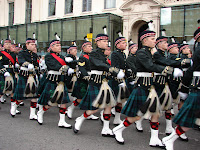


Glasgow, located on the Clyde River, was an industrial shipbuilding hub that has reinvented itself as a cultural center so there are plenty of museums and great architecture – old and new. Our Holiday Inn Riverview Hotel was a great location and reasonable. The bus stop was close by and so was the Scotia Pub, which was highly recommended by our taxi driver. The pub claims to be the oldest in Glasgow. It dates from 1792, is a good place for a bite to eat. It is quiet during the day but packed in the evening when they have live music.
The hop-on hop-off Sightseeing Glasgow bus tour ticket was good for two days. As is our practice, we took the tour once around and were deciding where to get off but when we got to George Square there was an event going on so we decided to check it out. It was their celebration of veteran’s day and people were waiting to see a parade. We checked out their military vehicles and listened to the music – a wannabe Frank Sinatra singing songs we knew. The parade was made up of marching and band units all decked out in their kilts and colorful uniforms. There were no fire trucks, floats or other participants – just the military units that did not have a military look instead they were dressed in colorful kilts and regalia.
After the parade we went to the People’s Palace where the focus is on the life of the ordinary people. It is located on the edge of the park with the beautiful Victorian Doulton Fountain, the world’s largest terracotta fountain, in front and the Winter Gardens in the back. One of the things I noticed in homes and museums in Ireland, Wales, and Scotland were matching China dogs. At the museum I learned that these ubiquitous dogs were called Wally Dugs. They were traditionally a cherished wedding gift with a special place on the fireplace mantle.
Regardless of the city, during the Industrial Revolution conditions for the poorest workers were miserable with people living in unhealthy and crowded conditions. It was the lucky family that had an entire room where they slept and cooked to call their home. Laws were passed limiting the number of people allowed in a room with 5 adults in a 2000 cubic foot room. However it was hard to enforce and rooms often held more than the allowed number. There were public laundries and bathhouses. It was hard to imagine the tough life of the workers.
Our next hop-off was at a Tenement House Museum. The museum is located in a tenement building that is still occupied and showed a different aspect of tenement living. The three-room apartment was the home of Agnes Toward for 50 years and I could image living there. There was a pretty sitting room, a kitchen and a bedroom. Toward lived there with her mother and they often had a tenant. I wondered where they all slept, that was until the guide opened what looked like a closet door and there was a built-in bed – not for the claustrophobic. There was a similar bed in the wall in the kitchen.
The shipbuilding area and riverside is in a renaissance with the building of the Exhibition and Convention Center and the Science Center across the river. The new Riverside Museum features transportation and shipbuilding.